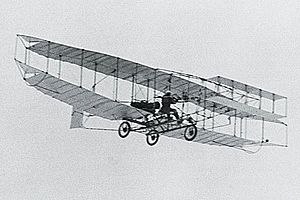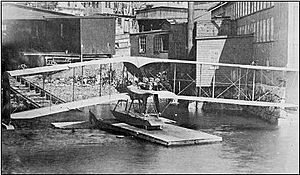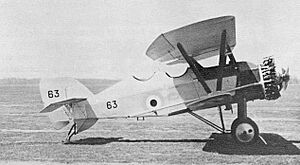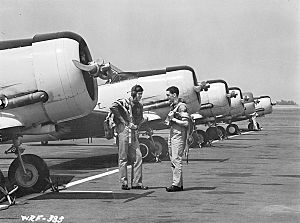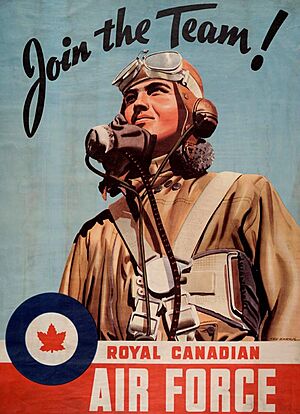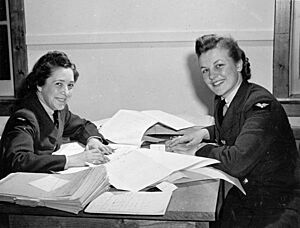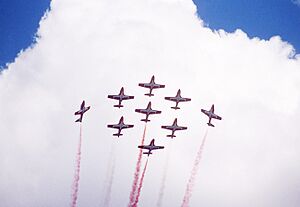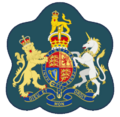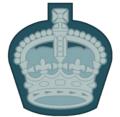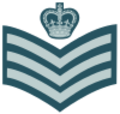History of the Royal Canadian Air Force facts for kids
The history of the Royal Canadian Air Force (RCAF) began way back in 1914. That's when the Canadian Aviation Corps (CAC) was formed during the First World War. They only had one aircraft, and it never even got to fly in the war! Later, in 1918, two Canadian squadrons formed the Canadian Air Force (CAF) in England, but they also didn't get to see wartime action.
After the war, in 1920, a new CAF was created in Canada. Then, in 1924, King George V gave them the special "Royal" title, and they became the Royal Canadian Air Force (RCAF). The RCAF was its own independent service until 1968.
Today, the Royal Canadian Air Force is part of the larger Canadian Forces. It has played a big role in the Second World War, the Korean War, and many United Nations peacekeeping missions and NATO operations around the world.
Contents
How Canada's Air Force Began
Early Flights in Canada
Canada's first ever flight in a powered airplane happened on February 23, 1909. It was the Silver Dart, flown by J.A.D. McCurdy over a frozen lake in Nova Scotia. This flight showed that planes could be useful for the military.
McCurdy and his partner, F. W. "Casey" Baldwin, hoped the government would buy their planes. They even showed off the Silver Dart at a military camp. It flew well at first, but then crashed on landing and couldn't fly again. Another plane they had also got damaged. After these accidents, the military wasn't interested in planes anymore. It took until the First World War for the Canadian government to see the importance of military aircraft.
The First World War and Canadian Pilots
When the First World War started in August 1914, Canada joined because Britain did. Other countries were already using planes in battle. Canada's Minister of Militia and Defence, Sam Hughes, wanted to help with military aviation. London asked for six experienced pilots, but Canada didn't have them.
Hughes did approve a small aviation unit called the Canadian Aviation Corps (CAC). It was formed in September 1914 with two officers and one mechanic. They bought a Burgess-Dunne biplane and sent it to England. But the plane never flew there. It got ruined by the damp winter weather. By May 1915, the CAC was gone.
During the war, over 20,000 Canadians volunteered to fly with British air forces. Many became famous pilots, like William Barker and W.A. "Billy" Bishop. In 1917, the British opened training airfields in Canada to train more Canadian airmen.
In 1918, Canada decided to form its own air units. The British Air Ministry created two Canadian squadrons. On September 19, 1918, the Canadian government officially created the Canadian Air Force (CAF) to control these squadrons. Billy Bishop, a top Canadian pilot, was put in charge. However, these squadrons were disbanded in February 1920 and never saw any combat.
Creating a Permanent Air Force
The Air Board and Early Canadian Air Force
After the First World War, Canada realized it needed to manage aviation. The war had left Canada with many trained pilots and aircraft. The government wanted to use these for non-military flying, like helping with civil (non-military) flights. Canada also had to follow international rules for air travel.
So, the Air Board was created. Its main job was to set rules for aviation. It also managed over 100 planes given to Canada by the British. These planes were used for things like forestry patrols, photographic surveying, and stopping smugglers. Six air stations were set up for these civil flying jobs.
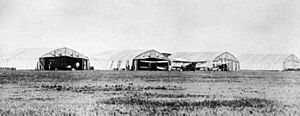
The Air Board also started a small, part-time military air group called the Canadian Air Force (CAF). This was to give refresher training to former wartime pilots. This training lasted from July 1920 to March 1922.
In 1922, the Air Board, along with the army and navy departments, joined together to form the Department of National Defence. The CAF became a new part of this department. By 1923, the CAF was in charge of all flying in Canada, including civil aviation.
The Royal Canadian Air Force is Born
The idea of calling the Canadian Air Force "Royal" came after Australia's air force got the title in 1921. Canada officially asked for the title in January 1923. On February 15, 1923, King George V agreed! The Canadian government officially recognized the new name, Royal Canadian Air Force (RCAF), on April 1, 1924.
With this new name, Canada's air force became a permanent part of the country's defence. The RCAF took over from the Air Board and continued civil tasks. These included watching for forest fires, spraying forests, delivering mail, and helping in emergencies.
In the early 1930s, the RCAF faced budget cuts. This meant fewer people, less training, and fewer new planes. But the air force started to rebuild through the 1930s. They focused on becoming a stronger military force. New planes were ordered, and new air stations were built. By the end of the 1930s, the RCAF was growing, but it still wasn't a major military power. Many of its planes were old, and it didn't have much experience in military operations.
The Second World War
When the Second World War began, the RCAF had 11 active squadrons. By October 1939, they had 15 squadrons ready. The RCAF started the war with only 29 front-line fighter and bomber planes. But it grew very quickly! By January 1944, the RCAF had 215,000 people. By the end of the war, it was the fourth-largest Allied air force. About 13,000 RCAF members died during operations or as prisoners of war. Another 4,000 died during training or from other reasons.
During the war, the RCAF focused on three main areas: the British Commonwealth Air Training Plan, home defence, and overseas operations.
Training Pilots for War
In 1939, Canada, the United Kingdom, Australia, and New Zealand agreed to train aircrew for the war. This huge training program was called the British Commonwealth Air Training Plan (BCATP). Canada managed it, and the RCAF was in charge. Training airfields and facilities were built all across Canada. Canada's training schools provided most of the aircrew for overseas operations.
The BCATP had many different types of schools. These included schools for basic training, flying, instructing, navigation, and gunnery. This plan trained over 130,000 aircrew members for the war effort.
Protecting Canada at Home
Canada's home defence was managed by two commands: Western Air Command and Eastern Air Command. These were on the west and east coasts. They grew to 37 squadrons. Their job was to protect Canada's coasts from enemy attacks and to keep Allied ships safe. They watched for German U-boats (submarines) in the Atlantic and were ready for possible attacks by Japanese forces on the west coast. After the attack on Pearl Harbor in 1941, more squadrons were sent to the west. Canadian units even went to Alaska to help the Americans.
Fighting Overseas
Forty-eight RCAF squadrons fought overseas in Britain, Europe, North Africa, and Southeast Asia. These squadrons did many different jobs, like flying fighter planes, night fighters, reconnaissance missions, and bombing raids. They also attacked ships and submarines, and transported supplies. RCAF squadrons often had non-RCAF members, and RCAF members also flew with British squadrons. Famous Canadian fighter pilots included George Beurling and James (Stocky) Edwards.
The RCAF played a big part in key battles. These included the Battle of Britain, fighting submarines in the Battle of the Atlantic, and bombing German industries. They also supported Allied forces during the Battle of Normandy and other land campaigns in Europe. RCAF squadrons and personnel also served in places like Egypt, Italy, and Burma.
By October 1942, the RCAF had five bomber squadrons with the British Bomber Command. In January 1943, 11 more bomber squadrons were formed, creating No. 6 Group RCAF of Bomber Command. This group was based in England and flew missions to Germany.
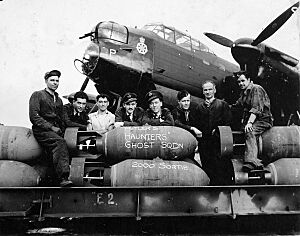
No. 6 Group faced heavy losses during bombing raids over Germany. This made morale difficult. On one night in January 1944, 9 out of 147 bombers were shot down over Berlin. The next night, 24 out of 125 bombers were lost. These high losses led to a new commander, Air Vice-Marshal C.M "Black Mike" McEwen. He improved training for pilots and ground crews.
In March 1944, the bombing of Germany stopped for a while. Bomber Command started bombing targets in France to prepare for D-Day. These flights were shorter and easier on the crews. The strategic bombing of Germany started again in October 1944. By the end of 1944, No. 6 Group had the lowest losses and highest accuracy of any Bomber Command group. Overall, 9,980 Canadians died in bombing raids against German cities during the war.

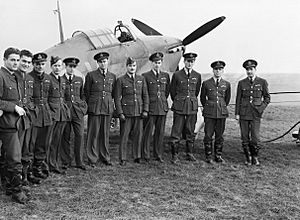
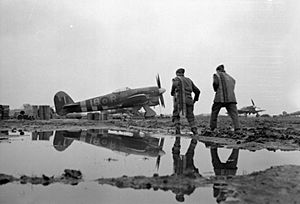
The Cold War Era
After the Second World War, the RCAF was much smaller. By the end of 1947, it had five squadrons and about 12,000 people. They went back to peacetime activities like aerial photography, mapping, search and rescue, and mercy missions. In 1947, the RCAF got its first helicopters, which were used for training and rescue.
By 1948, the Soviet bloc was seen as a threat, and the Cold War began. The RCAF started to grow again. They got new jet aircraft, like the Sabre and the Avro CF-100 Canuck. The RCAF was even the first air force to use jet transport planes, with two Comets in 1953.
In 1949, Canada joined NATO. As part of its commitment, the RCAF set up an Air Division in Europe with four wings (groups of squadrons). These wings, flying CF-100s and Sabres, were a key part of NATO's air defence in the 1950s.
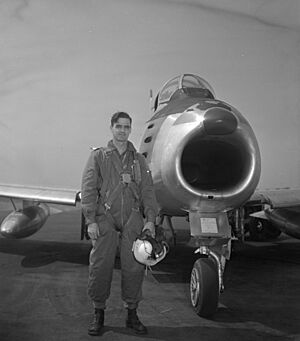
In 1950, the RCAF helped a lot with transporting people and supplies for the Korean War. While RCAF squadrons didn't fight directly, 22 RCAF fighter pilots flew with the USAF in Korea. Some, like Flight Lieutenant E. A. "Ernie" Glover, even shot down enemy planes.
To protect against Soviet bombers, the RCAF and USAF built radar stations across Canada. These were the Pinetree Line, the Mid-Canada Line, and the DEW Line in the Arctic. This led to the creation of North American Air Defense Command (NORAD) in 1957, a partnership between Canada and the US to defend North American airspace.
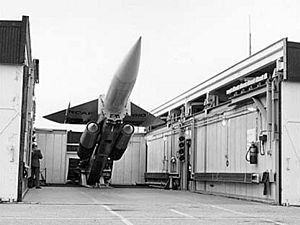
The RCAF also started developing the Avro CF-105 Arrow fighter jet. But as the Soviet threat changed from bombers to long-range missiles, the Arrow program was cancelled. Instead, Canada got Bomarc anti-aircraft missiles.
The RCAF also replaced its older planes with newer ones. For example, the CF-101 Voodoo replaced the CF-100 for air defence, and the CF-104 Starfighter replaced the Sabres for strike and reconnaissance missions. Maritime patrol squadrons used planes like the Argus to hunt submarines. The RCAF also helped with peacekeeping by transporting troops and supplies to troubled areas.
Many RCAF aerobatic teams, like the Golden Hawks, showed off their flying skills during this time. By 1954, the RCAF had grown to 54,000 people and 41 squadrons.
Joining Forces: Unification and Air Command
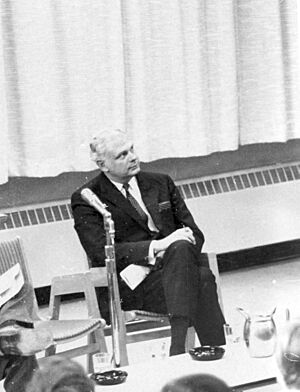
In 1964, the Canadian government decided to combine the RCAF with the Royal Canadian Navy (RCN) and the Canadian Army. This was called the unification and aimed to save money and make the military more efficient. On February 1, 1968, the RCAF officially stopped being a separate service. The three branches became one unified Canadian Forces.
Six new commands were created:
- Mobile Command: For ground forces and their helicopters.
- Maritime Command: For aircraft supporting navy ships and patrol missions.
- Air Defence Command: For fighter jets and radar networks.
- Air Transport Command: For moving troops and supplies over long distances.
- Training Command: For all military training.
- Materiel Command: For maintenance and supplies.
In 1971, the famous Snowbirds aerobatic team was officially formed. They fly CT-114 Tutor trainer jets and continue to show off the amazing flying skills of Canadian air force personnel.
On September 2, 1975, all the air assets from the different commands were brought together under a new command called Air Command (AIRCOM). This new command was very much like the old RCAF, handling all the aviation needs for Canada's military.
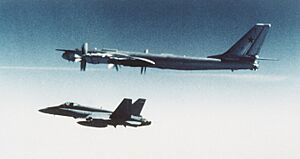
Over the years, some bases closed as new aircraft were introduced. For example, when the CF-18 Hornet fighter jets arrived, older planes like the CF-104 Starfighter were retired. Radar stations were also updated or closed. In the late 1970s, AIRCOM replaced older maritime patrol planes with the CP-140 Aurora aircraft.
The Modern Air Force
After the Cold War ended, the government made budget cuts. This led to some bases closing. In the early 1990s, AIRCOM updated its transport and utility helicopters. They bought the CH-146 Griffon, replacing several older models. The Airbus CC-150 Polaris replaced the older transport aircraft.
Search and rescue squadrons also got new aircraft, with the CH-149 Cormorant replacing the CH-113 Labrador starting in 2002. More recently, in 2007 and 2008, four C-17 Globemaster IIIs were added to improve transportation. Seventeen CC-130J Super Hercules transport planes were also acquired by 2012.
In 1997, the air force's structure was changed again, with 11 operational "wings" across Canada. In 2009, 2 Canadian Air Division (2 CAD) was created to focus on air force training.
On August 16, 2011, the Canadian government announced that "Air Command" would change back to its original historic name: Royal Canadian Air Force. This change was made to honor Canada's military history and align with other Commonwealth countries.
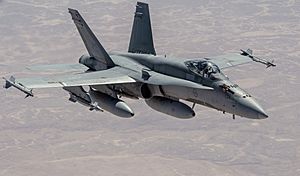
From March to November 2011, RCAF CF-18 Hornet fighter jets and transport planes were sent as part of Operation Mobile, Canada's response to the Libyan uprising. They helped enforce a no-fly zone and carried out bomb strikes. In 2014, RCAF aircraft also helped supply military aid to Iraq as part of Operation Impact, with CF-18s conducting combat air strikes.
Brave Heroes: Victoria Cross Recipients
The Victoria Cross (VC) is the highest award for bravery given to military personnel in Britain and the Commonwealth. Two members of the Royal Canadian Air Force have received this incredible honor since 1924:
- Pilot Officer Andrew Charles Mynarski, for bravery during a mission over Cambrai, France, on June 12, 1944.
- Flight Lieutenant David Ernest Hornell, for bravery during a mission near the Faroe Islands, on June 24, 1944.
Women in the RCAF
The Canadian Women's Auxiliary Air Force (CWAAF) was formed in 1941. Its goal was to have women take over jobs that would free up more men for wartime training and combat. The unit's name changed to the Royal Canadian Air Force Women's Division (WD) in 1942.
After the war, the Women's Division was stopped. But women were allowed to join the RCAF again in 1951 when the air force was growing. In 1980, women were accepted as military pilots. Canada became the first Western country to allow women to be fighter pilots in 1988.
RCAF Symbols and Markings
Roundels: Air Force Circles
The RCAF used British roundels (the circular symbols on aircraft) until 1946. Then, Canada started using its own unique symbols. During the Second World War, the red circle on some British roundels was changed to avoid confusion with Japanese symbols.
Canada was the first Commonwealth country to create its own roundel. A maple leaf replaced the inner circle to give it a distinct Canadian look. Even though the maple leaf roundel was approved in 1924, it wasn't widely used on aircraft until after the war.
In February 1965, the realistic maple leaf was replaced with the eleven-point stylized leaf from the new Canadian flag. This new roundel is still used by the RCAF today, sometimes in a low-visibility grey version.
Fin Flashes: Tail Markings
RCAF aircraft used a British "fin flash" on their tails. This was a red and blue vertical stripe with a white stripe in between. In 1955, the red ensign Canadian Flag started to replace the fin flash on planes based in Europe. On planes in Canada, it started in 1958. Since 1965, the new Canadian flag has been used on the tail.
Ensign: The RCAF Flag
The original RCAF flag was based on the British RAF flag, a light blue flag. But it had the Canadian roundel. The RCAF started using its own flag with the maple leaf roundel in 1941. This flag was stopped when the military branches were unified. But a modified version was brought back by Air Command in 1985. The current RCAF still uses this flag.
Badge: The Official Symbol
The original RCAF badge was similar to those of other Commonwealth air forces. It had a crown, a flying eagle, and a circle with the motto per ardua ad astra (meaning "Through Adversity to the Stars"). This motto was changed in 1968 to Sic itur ad astra, meaning "such is the pathway to the stars," which is still used today. The badge also had a scroll with "Royal Canadian Air Force."
When the services were unified, the original badge disappeared. Air Command adopted a new design. But in September 2013, a new badge was introduced. It brought back the flying eagle from the old RCAF badge.
Tartan: A Unique Pattern
The Royal Canadian Air Force Tartan is a special patterned fabric. It was designed in Scotland at the RCAF's request and is based on the Anderson tartan. Its main colors are dark blue, light blue, and maroon. The design was officially approved in May 1942. The tartan was used on RCAF pipe band kilts and other clothing. It is still used today.
RCAF in Films
Canada's air force has been featured in many films and documentaries:
- Captains of the Clouds (1942): About Canadian bush pilots in the British Commonwealth Air Training Plan.
- Wings on her Shoulder (1943): A documentary about the Women's Division.
- Train Busters (1943): A documentary about RCAF air power in the Second World War.
- Wasp Wings (1945): A documentary about three RCAF wings.
- Canada's Air Defence (1956): A documentary about the RCAF's role in air defence.
- Fighter Wing (1956): A documentary about RCAF pilots in West Germany.
- Airwomen (1956): A film about a fighter control operator.
- For the Moment (1993): About airmen training in Manitoba during the war.
- Ordeal in the Arctic (1993): A film about a Canadian Forces aircraft crash on Ellesmere Island.
- Lost Over Burma: Search for Closure (1997): A documentary about finding the crew of an RCAF plane lost in Burma during the Second World War.
- Last Flight to Berlin: The Search for a Bomber Pilot (2005): A film about a son searching for information about his RCAF bomber pilot father who died in Berlin.
- Jetstream (2008): A TV series following pilots training to fly the CF-18 Hornet.
Images for kids
See also
- Royal Canadian Air Force Association
- History of aviation in Canada
- List of Royal Canadian Air Force squadrons
- List of Royal Canadian Air Force stations
- List of aircraft of Canada's air forces
- Royal Canadian Air Force Police
- RCAF March Past
- Royal Air Force roundels
- Royal Canadian Air Force Band


